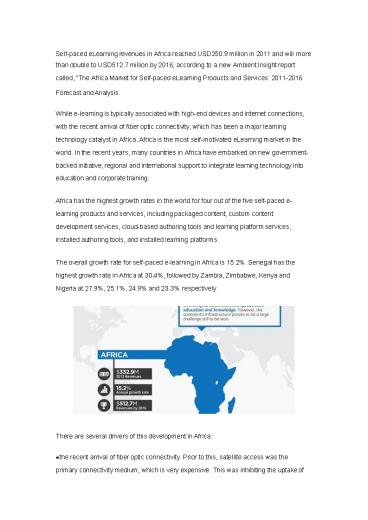2014-2016 E-learning Market Trends — African E-learning Market - PowerPoint PPT Presentation
Title:
2014-2016 E-learning Market Trends — African E-learning Market
Description:
Self-paced eLearning revenues in Africa reached USD250.9 million in 2011 and will more than double to USD512.7 million by 2016, according to a new Ambient Insight report called. – PowerPoint PPT presentation
Number of Views:11
Title: 2014-2016 E-learning Market Trends — African E-learning Market
1
Self-paced eLearning revenues in Africa reached
USD250.9 million in 2011 and will more than
double to USD512.7 million by 2016, according to
a new Ambient Insight report called, The Africa
Market for Self-paced eLearning Products and
Services 2011-2016 Forecast and Analysis. While
e-learning is typically associated with high-end
devices and internet connections, with the
recent arrival of fiber optic connectivity, which
has been a major learning technology catalyst in
Africa. Africa is the most self-motivated
eLearning market in the world. In the recent
years, many countries in Africa have embarked on
new government- backed initiative, regional and
international support to integrate learning
technology into education and corporate
training. Africa has the highest growth rates in
the world for four out of the five self-paced e-
learning products and services, including
packaged content, custom content development
services, cloud-based authoring tools and
learning platform services, installed authoring
tools, and installed learning platforms. The
overall growth rate for self-paced e-learning in
Africa is 15.2. Senegal has the highest growth
rate in Africa at 30.4, followed by Zambia,
Zimbabwe, Kenya and Nigeria at 27.9, 25.1,
24.9 and 23.3 respectively.
- There are several drivers of this development in
Africa - the recent arrival of fiber optic connectivity.
Prior to this, satellite access was the primary
connectivity medium, which is very expensive.
This was inhibiting the uptake of
2
- Internet connectivity
- a price war with telecoms and ISPs dropping
prices to attract customers. This has also
created a boom in the adoption of Internet and
mobile technologies - Internet penetration in Kenya essentially doubled
from 2010 to 2011, growing from 28 to 52 in
just one year. ? Internet penetration more than
tripled in Rwanda between 2011 and 2012, growing
from 8 to 26 in one year. - The wide scale digitization of academic content
in every country analyzed in this report - The explosion of online enrollments in higher
education institutions - the sharp spike in the adoption of eLearning in
the corporate segments in the booming economies. - National governments are not the only ones
playing a key role in the development of - information and communication technologies (ICT)
for education. Other sponsors of this trend are
international authorities, such as UNESCO, which
invests heavily in developing a modern framework
for education in the region. Most of these
initiatives are vertical, like UNESCOs
initiative to disseminate the important role
women have played in African - history.
- However, the development of a mature E-Learning
market in Africa is still restricted by the lack
of proper IT infrastructures and connectivity
solutions. According to 2012 estimates, Internet
penetration in Africa has reached only 15.6. - Although the number of people on whom the
internet has an impact is undoubtedly higher,
this statistic demonstrates a significant
infrastructural disparity between Africa and the
other continents. Today, the fast-growing market
for mobile devices looks to be the strongest
trend that will support the development of
E-Learning in Africa. - https//www.eztalks.com/elearning/2014-2016-africa
n-e-learning-market-trends.html































